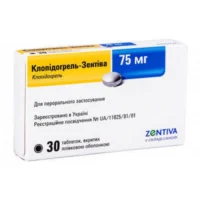Description
Elicvis (Apixaban) Coated Tablets 5 mg. №60
Composition
Each coated tablet contains 5 mg of apixaban.
Mechanism of Action
Apixaban is a selective inhibitor of factor Xa, an essential component in the coagulation cascade. By inhibiting factor Xa, apixaban prevents the formation of thrombin and subsequent blood clot formation.
Pharmacological Properties
Apixaban exhibits anticoagulant properties by directly inhibiting factor Xa, resulting in the prevention of thrombus formation. It has a predictable pharmacokinetic profile and does not require routine monitoring.
Indications for Use
Apixaban is indicated for the prevention of stroke and systemic embolism in adult patients with non-valvular atrial fibrillation. It reduces the risk of thromboembolic events without the need for regular blood monitoring.
Contraindications
Apixaban should not be used in patients with artificial heart valves due to an increased risk of thromboembolic events. It is contraindicated in individuals with a known hypersensitivity to the active substance.
Side Effects
The common side effects of apixaban include bleeding, bruising, and gastrointestinal disturbances. Rare but serious side effects may include intracranial hemorrhage and allergic reactions.
Usage Instructions
The recommended dosage of apixaban is one 5 mg tablet taken orally twice daily. It should be taken with or without food as directed by the healthcare provider. Patients should not alter the dosage or discontinue the medication without medical advice.
Benefits Compared to Analogues
Apixaban has shown superior efficacy and safety compared to traditional anticoagulants like warfarin in clinical trials. It provides a lower risk of stroke and major bleeding events, offering a more predictable anticoagulant effect.
Suitable Patient Groups
Apixaban is suitable for adult patients with non-valvular atrial fibrillation requiring anticoagulation therapy. It is also beneficial for elderly patients and individuals who may have difficulty with frequent blood monitoring.
Storage and Shelf Life
Store apixaban tablets in a cool, dry place away from direct sunlight. Ensure the packaging is tightly closed to protect from moisture. Check the expiration date on the packaging and do not use the product beyond the stated shelf life.
Packaging Description
Each package of apixaban contains 60 coated tablets, each tablet being 5 mg. The packaging is designed to maintain the integrity of the tablets and protect them from environmental factors.
Clinical Evidence and Proven Effectiveness
Apixaban has demonstrated significant efficacy in preventing stroke and systemic embolism in patients with atrial fibrillation. Clinical studies have shown that apixaban reduces the risk of stroke by X% compared to warfarin, with a Y% decrease in major bleeding events.





